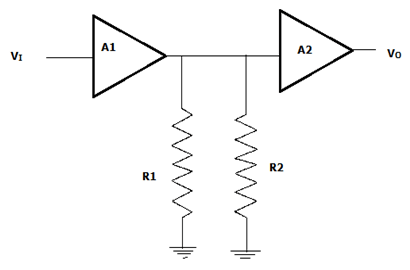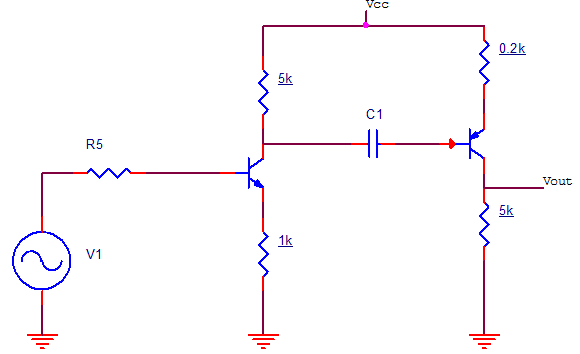This set of Analog Circuits Multiple Choice Questions & Answers (MCQs) focuses on “Cascaded Amplifier”.
1. For any cascaded amplifier network, which of these are incorrect?
a) Cascading increases gain
b) Overall input resistance is equal to the input resistance of the first amplifier
c) The overall output resistance is less than the lowest output resistance in all amplifiers used
d) Loading effect occurs
View Answer
Explanation: In cascading, the output of one amplifier is connected to the input of another amplifier. It is used to increase gain while obtaining desired values of input and output resistances. Overall input resistance is the same as input resistance of the first amplifier and net output resistance is the same as output resistance of the last (nth) amplifier in the network. When amplifiers are connected in cascade, then loading effect does occur.
2. Consider the circuit.

Loading effect occurs when ______________
a) R2 is small
b) A1 is small
c) R2 is large
d) A2 is large
View Answer
Explanation: Loading effect refers to the effect of the input resistance of the nth amplifier in the net load resistance of the n-1th amplifier. The decrease of voltage gain of A1 above, due to smaller input resistance R2 of A2 is called loading effect. If the amplifier has larger input resistance, that is if R2 is large, no loading effect occurs. Such amplifiers are called non-interacting amplifiers.
3. Consider the circuit shown.

Find internal voltage gain of the network given gm = 50mΩ-1 and β = 100.
a) 100
b) -90
c) 90
d) 95
View Answer
Explanation: Both are CE amplifiers without a bypass capacitor.
For this, voltage gain is AV = -gmRL’/1+gmRE
A2 = -50 x 5/1 + 50 x 0.2 = -22.7
RL1 = 5k||RI2
RI2 = rπ + (1+β)RE = 100/50m + 101 x 0.2k = 2k + 20.2k = 22.2k
RL1 = 4.08kΩ
A1 = -50×4.08/1+ 50×1 = – 4
Gain = A’ = A1 x A2 = 90.8.
4. Cascading increases lower cut-off frequencies.
a) True
b) False
View Answer
Explanation: Considering each amplifier has lower cut-off frequency fL1 then net lower cut-off frequency for a network of N cascaded amplifiers is fL = \(\frac{f_{L1}}{\sqrt{2^{1/N}}-1}\)
For N>=2, \(\sqrt{2^{1/N}}-1\) < 1, thus fL > fL1.
5. 6 similar amplifiers are cascaded, with lower cut-off frequency 100Hz. Bandwidth is B1=10 kHz. What is the higher cut-off frequency of the cascaded network?
a) 4000 Hz
b) 1667 Hz
c) 3642 Hz
d) 3000 Hz
View Answer
Explanation: fL1 = 50 Hz
fL = 50/ \(\sqrt{2^{1/6}}-1\) = 142 Hz
B1 = 10kHz
B2 = B1 \(\sqrt{2^{1/N}}-1\) = 3.5 Khz
fH – fL = 3500
fH = 3642 Hz.
6. It is provided that the lower cut-off frequency of an individual amplifier is 25Hz, find the net cut-off frequency of a cascaded network of 8 similar amplifiers.
a) 200 Hz
b) 83 Hz
c) 100 Hz
d) 25 Hz
View Answer
Explanation: fL1 = 25Hz
fL = \(\frac{f_{L1}}{\sqrt{2^{1/N}}-1} = \frac{25}{\sqrt{2^{1/8}} -1} = \frac{25}{\sqrt{0.0905}}\)
fL = 83 Hz.
7. Given that the higher cut-off frequency of the cascaded network of 6 amplifiers is 2Mhz, find the higher cut-off frequency of one amplifier, if all amplifiers are similar.
a) 5.7 Mhz
b) 0.33 Mhz
c) 12 Mhz
d) 64 Mhz
View Answer
Explanation: fH = 2Mhz
fH = fH1 \(\sqrt{2^{1/N}}-1\)
fH1 = 2Mhz/√\(\sqrt{2^{1/6}}-1\) = 5.71 Mhz.
8. The lower and upper cutoff frequencies of an amplifier are unknown. If originally, individual BW of such an amplifier is B1, and now the bandwidth of the cascaded network of 10 such amplifiers is B2, find B2/B1.
a) 0.26
b) 3.84
c) Insufficient data
d) 5
View Answer
Explanation: To calculate net bandwidth B2 = B1 x \(\sqrt{2^{1/N}}-1\)
B2/B1 = \(\sqrt{2^{1/N}}-1\)
B2/B1 = 0.26.
9. Provided a cascade multistage amplifier network, their pole frequencies obtained are f1=10Mhz, f2=12Mhz, f3=20Mhz, f4=16Mhz. What is the approximate higher cutoff frequency of the cascaded network?
a) 3.4 Mhz
b) 8 Mhz
c) 5 Mhz
d) 6 Mhz
View Answer
Explanation: The net frequency
1/fH = 1/f1 + 1/f2 + 1/f3 + 1/f4 and so on for multiple stages.
1/fH = 0.295833
fH ≈ 3.4 Mhz.
Sanfoundry Global Education & Learning Series – Analog Circuits.
To practice all areas of Analog Circuits, here is complete set of 1000+ Multiple Choice Questions and Answers.
If you find a mistake in question / option / answer, kindly take a screenshot and email to [email protected]
